Comprehensive Report on Indirect Tax: VAT Regulations and Compliance
VerifiedAdded on 2021/01/01
|14
|3898
|104
Report
AI Summary
This report provides a comprehensive overview of Value Added Tax (VAT) regulations, focusing on compliance and reporting requirements. It details the sources of VAT information, the interaction between organizations and the relevant governance agency (HMRC), and the requirements for VAT registration. The report outlines the information that must be included on business documents for VAT-registered businesses, and it explains various VAT schemes like annual accounting, cash accounting, flat-rate, and standard rate schemes. Furthermore, the report covers the importance of maintaining up-to-date knowledge of changes to VAT regulations, the process of extracting relevant data from accounting systems, and the calculation of VAT liabilities. It also addresses the completion and submission of VAT returns, along with the implications and penalties for non-compliance. Finally, the report discusses the impact of VAT payments on cash flow and financial forecasts, offering advice on communicating changes in VAT legislation to relevant stakeholders.
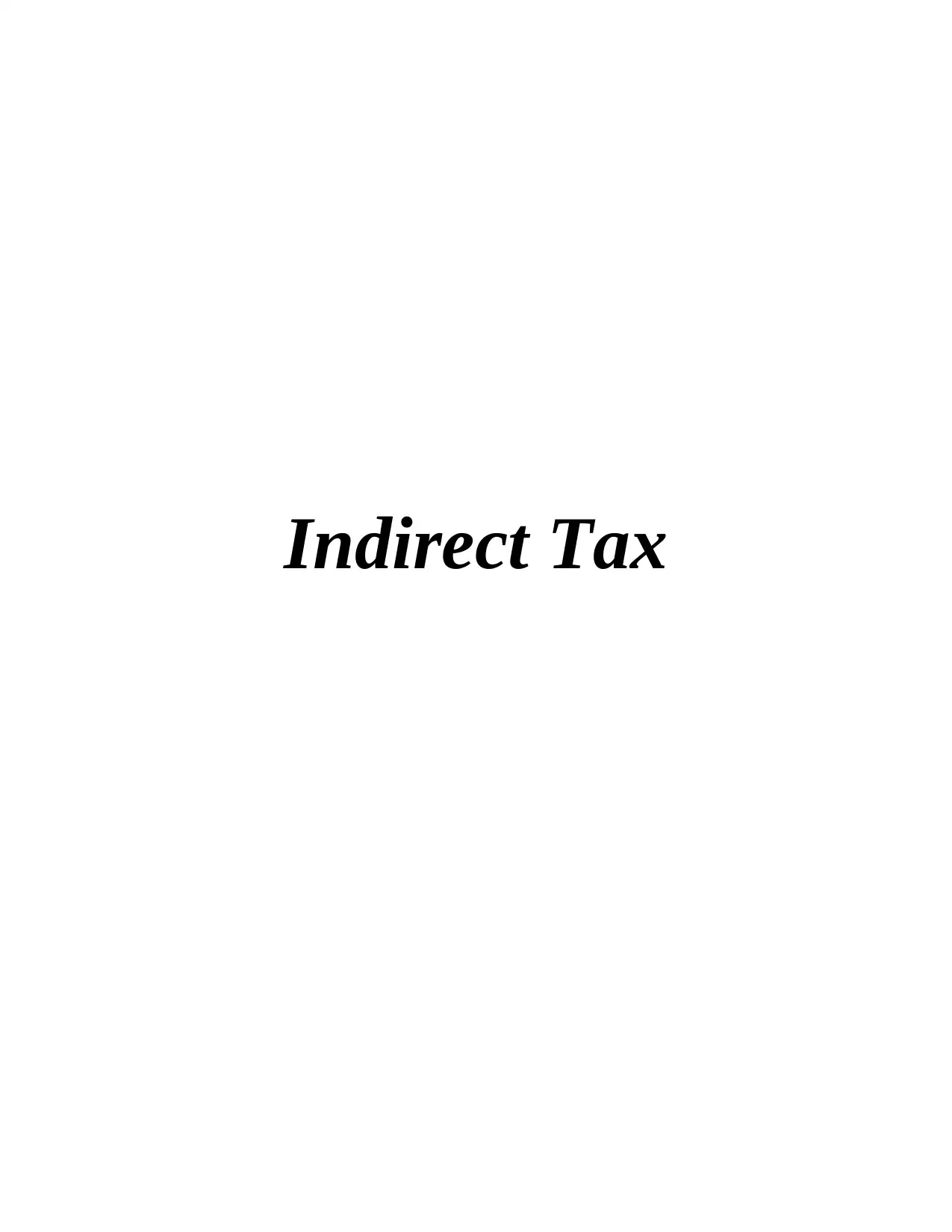
Indirect Tax
Paraphrase This Document
Need a fresh take? Get an instant paraphrase of this document with our AI Paraphraser
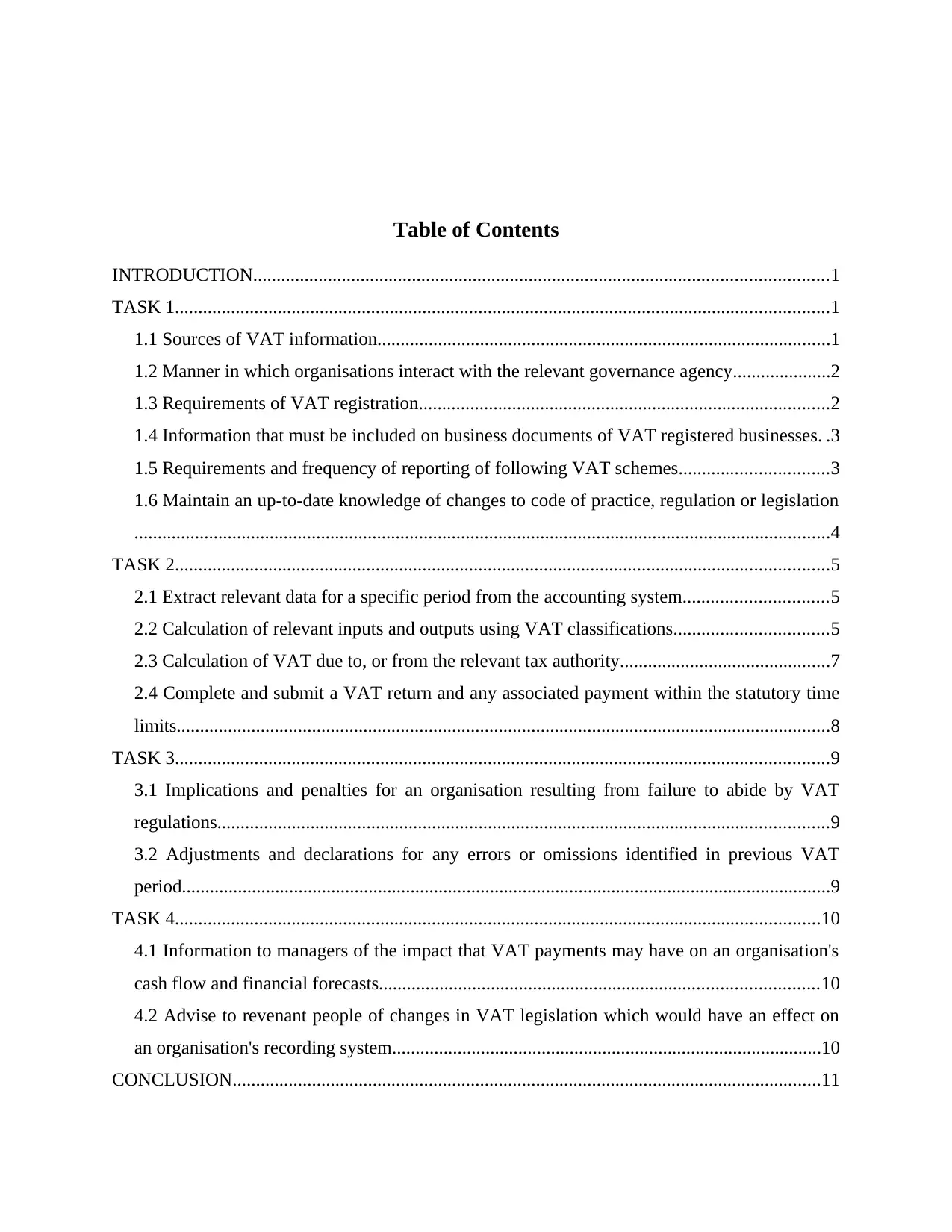
Table of Contents
INTRODUCTION...........................................................................................................................1
TASK 1............................................................................................................................................1
1.1 Sources of VAT information.................................................................................................1
1.2 Manner in which organisations interact with the relevant governance agency.....................2
1.3 Requirements of VAT registration........................................................................................2
1.4 Information that must be included on business documents of VAT registered businesses. .3
1.5 Requirements and frequency of reporting of following VAT schemes................................3
1.6 Maintain an up-to-date knowledge of changes to code of practice, regulation or legislation
.....................................................................................................................................................4
TASK 2............................................................................................................................................5
2.1 Extract relevant data for a specific period from the accounting system...............................5
2.2 Calculation of relevant inputs and outputs using VAT classifications.................................5
2.3 Calculation of VAT due to, or from the relevant tax authority.............................................7
2.4 Complete and submit a VAT return and any associated payment within the statutory time
limits............................................................................................................................................8
TASK 3............................................................................................................................................9
3.1 Implications and penalties for an organisation resulting from failure to abide by VAT
regulations...................................................................................................................................9
3.2 Adjustments and declarations for any errors or omissions identified in previous VAT
period...........................................................................................................................................9
TASK 4..........................................................................................................................................10
4.1 Information to managers of the impact that VAT payments may have on an organisation's
cash flow and financial forecasts..............................................................................................10
4.2 Advise to revenant people of changes in VAT legislation which would have an effect on
an organisation's recording system............................................................................................10
CONCLUSION..............................................................................................................................11
INTRODUCTION...........................................................................................................................1
TASK 1............................................................................................................................................1
1.1 Sources of VAT information.................................................................................................1
1.2 Manner in which organisations interact with the relevant governance agency.....................2
1.3 Requirements of VAT registration........................................................................................2
1.4 Information that must be included on business documents of VAT registered businesses. .3
1.5 Requirements and frequency of reporting of following VAT schemes................................3
1.6 Maintain an up-to-date knowledge of changes to code of practice, regulation or legislation
.....................................................................................................................................................4
TASK 2............................................................................................................................................5
2.1 Extract relevant data for a specific period from the accounting system...............................5
2.2 Calculation of relevant inputs and outputs using VAT classifications.................................5
2.3 Calculation of VAT due to, or from the relevant tax authority.............................................7
2.4 Complete and submit a VAT return and any associated payment within the statutory time
limits............................................................................................................................................8
TASK 3............................................................................................................................................9
3.1 Implications and penalties for an organisation resulting from failure to abide by VAT
regulations...................................................................................................................................9
3.2 Adjustments and declarations for any errors or omissions identified in previous VAT
period...........................................................................................................................................9
TASK 4..........................................................................................................................................10
4.1 Information to managers of the impact that VAT payments may have on an organisation's
cash flow and financial forecasts..............................................................................................10
4.2 Advise to revenant people of changes in VAT legislation which would have an effect on
an organisation's recording system............................................................................................10
CONCLUSION..............................................................................................................................11

.......................................................................................................................................................11
REFERENCES..............................................................................................................................12
REFERENCES..............................................................................................................................12
⊘ This is a preview!⊘
Do you want full access?
Subscribe today to unlock all pages.

Trusted by 1+ million students worldwide
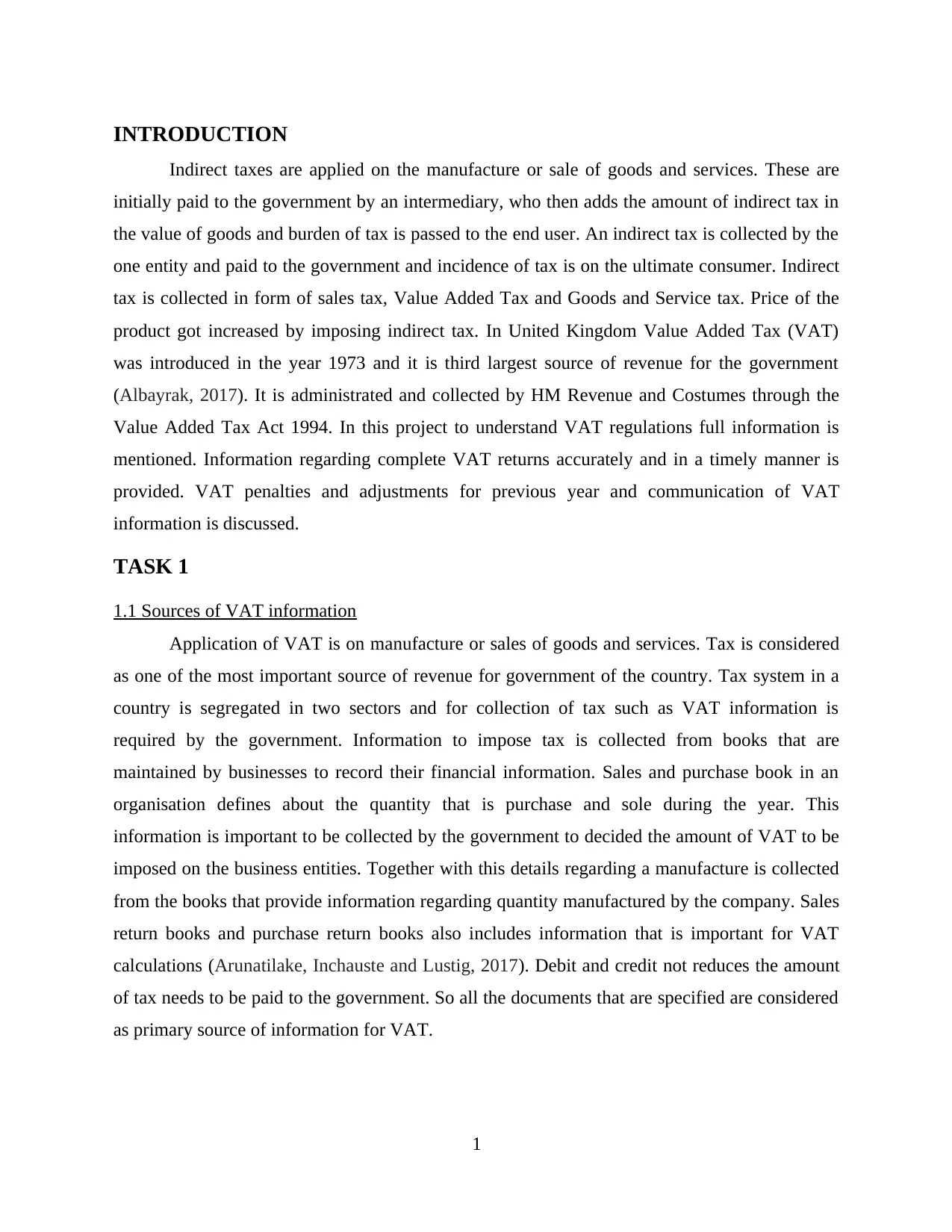
INTRODUCTION
Indirect taxes are applied on the manufacture or sale of goods and services. These are
initially paid to the government by an intermediary, who then adds the amount of indirect tax in
the value of goods and burden of tax is passed to the end user. An indirect tax is collected by the
one entity and paid to the government and incidence of tax is on the ultimate consumer. Indirect
tax is collected in form of sales tax, Value Added Tax and Goods and Service tax. Price of the
product got increased by imposing indirect tax. In United Kingdom Value Added Tax (VAT)
was introduced in the year 1973 and it is third largest source of revenue for the government
(Albayrak, 2017). It is administrated and collected by HM Revenue and Costumes through the
Value Added Tax Act 1994. In this project to understand VAT regulations full information is
mentioned. Information regarding complete VAT returns accurately and in a timely manner is
provided. VAT penalties and adjustments for previous year and communication of VAT
information is discussed.
TASK 1
1.1 Sources of VAT information
Application of VAT is on manufacture or sales of goods and services. Tax is considered
as one of the most important source of revenue for government of the country. Tax system in a
country is segregated in two sectors and for collection of tax such as VAT information is
required by the government. Information to impose tax is collected from books that are
maintained by businesses to record their financial information. Sales and purchase book in an
organisation defines about the quantity that is purchase and sole during the year. This
information is important to be collected by the government to decided the amount of VAT to be
imposed on the business entities. Together with this details regarding a manufacture is collected
from the books that provide information regarding quantity manufactured by the company. Sales
return books and purchase return books also includes information that is important for VAT
calculations (Arunatilake, Inchauste and Lustig, 2017). Debit and credit not reduces the amount
of tax needs to be paid to the government. So all the documents that are specified are considered
as primary source of information for VAT.
1
Indirect taxes are applied on the manufacture or sale of goods and services. These are
initially paid to the government by an intermediary, who then adds the amount of indirect tax in
the value of goods and burden of tax is passed to the end user. An indirect tax is collected by the
one entity and paid to the government and incidence of tax is on the ultimate consumer. Indirect
tax is collected in form of sales tax, Value Added Tax and Goods and Service tax. Price of the
product got increased by imposing indirect tax. In United Kingdom Value Added Tax (VAT)
was introduced in the year 1973 and it is third largest source of revenue for the government
(Albayrak, 2017). It is administrated and collected by HM Revenue and Costumes through the
Value Added Tax Act 1994. In this project to understand VAT regulations full information is
mentioned. Information regarding complete VAT returns accurately and in a timely manner is
provided. VAT penalties and adjustments for previous year and communication of VAT
information is discussed.
TASK 1
1.1 Sources of VAT information
Application of VAT is on manufacture or sales of goods and services. Tax is considered
as one of the most important source of revenue for government of the country. Tax system in a
country is segregated in two sectors and for collection of tax such as VAT information is
required by the government. Information to impose tax is collected from books that are
maintained by businesses to record their financial information. Sales and purchase book in an
organisation defines about the quantity that is purchase and sole during the year. This
information is important to be collected by the government to decided the amount of VAT to be
imposed on the business entities. Together with this details regarding a manufacture is collected
from the books that provide information regarding quantity manufactured by the company. Sales
return books and purchase return books also includes information that is important for VAT
calculations (Arunatilake, Inchauste and Lustig, 2017). Debit and credit not reduces the amount
of tax needs to be paid to the government. So all the documents that are specified are considered
as primary source of information for VAT.
1
Paraphrase This Document
Need a fresh take? Get an instant paraphrase of this document with our AI Paraphraser
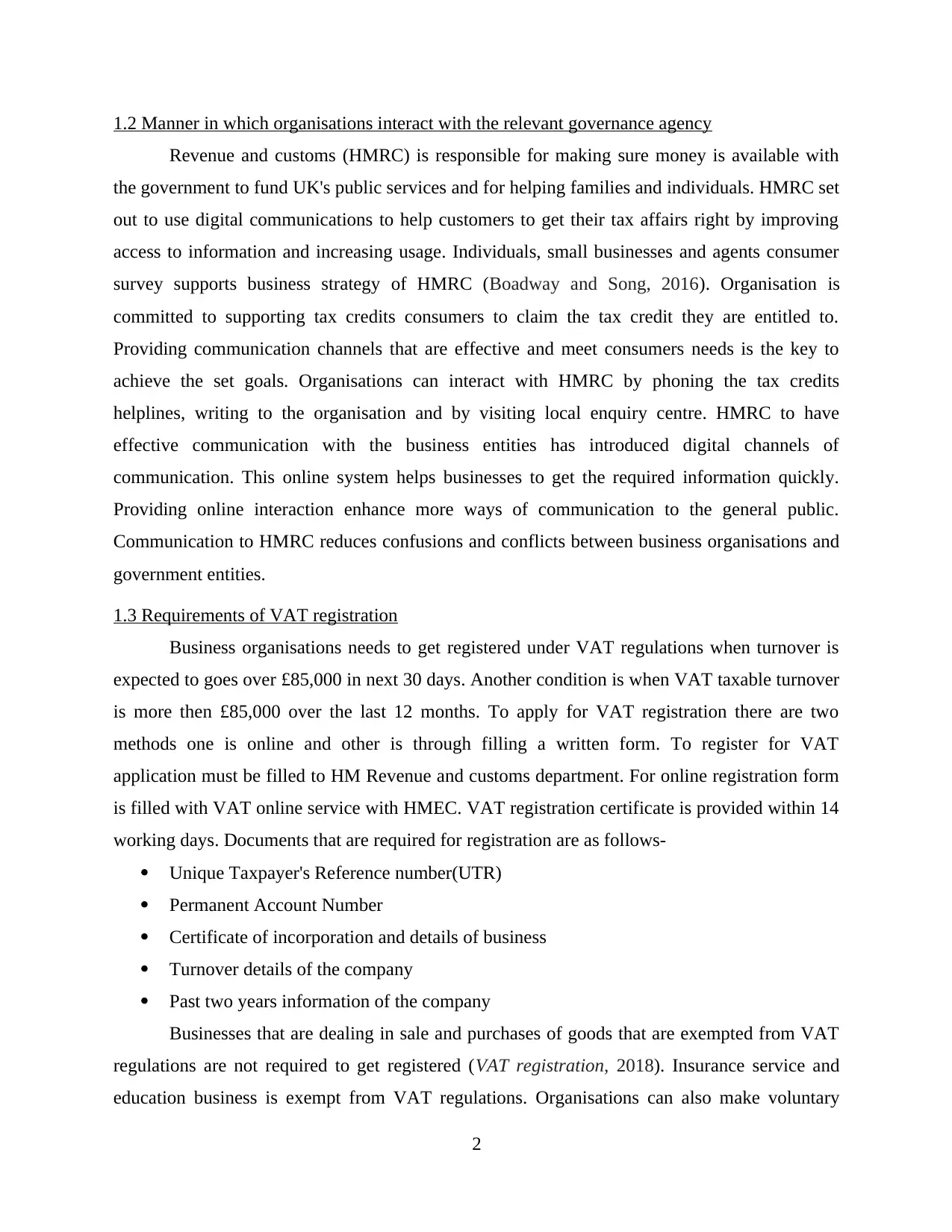
1.2 Manner in which organisations interact with the relevant governance agency
Revenue and customs (HMRC) is responsible for making sure money is available with
the government to fund UK's public services and for helping families and individuals. HMRC set
out to use digital communications to help customers to get their tax affairs right by improving
access to information and increasing usage. Individuals, small businesses and agents consumer
survey supports business strategy of HMRC (Boadway and Song, 2016). Organisation is
committed to supporting tax credits consumers to claim the tax credit they are entitled to.
Providing communication channels that are effective and meet consumers needs is the key to
achieve the set goals. Organisations can interact with HMRC by phoning the tax credits
helplines, writing to the organisation and by visiting local enquiry centre. HMRC to have
effective communication with the business entities has introduced digital channels of
communication. This online system helps businesses to get the required information quickly.
Providing online interaction enhance more ways of communication to the general public.
Communication to HMRC reduces confusions and conflicts between business organisations and
government entities.
1.3 Requirements of VAT registration
Business organisations needs to get registered under VAT regulations when turnover is
expected to goes over £85,000 in next 30 days. Another condition is when VAT taxable turnover
is more then £85,000 over the last 12 months. To apply for VAT registration there are two
methods one is online and other is through filling a written form. To register for VAT
application must be filled to HM Revenue and customs department. For online registration form
is filled with VAT online service with HMEC. VAT registration certificate is provided within 14
working days. Documents that are required for registration are as follows-
Unique Taxpayer's Reference number(UTR)
Permanent Account Number
Certificate of incorporation and details of business
Turnover details of the company
Past two years information of the company
Businesses that are dealing in sale and purchases of goods that are exempted from VAT
regulations are not required to get registered (VAT registration, 2018). Insurance service and
education business is exempt from VAT regulations. Organisations can also make voluntary
2
Revenue and customs (HMRC) is responsible for making sure money is available with
the government to fund UK's public services and for helping families and individuals. HMRC set
out to use digital communications to help customers to get their tax affairs right by improving
access to information and increasing usage. Individuals, small businesses and agents consumer
survey supports business strategy of HMRC (Boadway and Song, 2016). Organisation is
committed to supporting tax credits consumers to claim the tax credit they are entitled to.
Providing communication channels that are effective and meet consumers needs is the key to
achieve the set goals. Organisations can interact with HMRC by phoning the tax credits
helplines, writing to the organisation and by visiting local enquiry centre. HMRC to have
effective communication with the business entities has introduced digital channels of
communication. This online system helps businesses to get the required information quickly.
Providing online interaction enhance more ways of communication to the general public.
Communication to HMRC reduces confusions and conflicts between business organisations and
government entities.
1.3 Requirements of VAT registration
Business organisations needs to get registered under VAT regulations when turnover is
expected to goes over £85,000 in next 30 days. Another condition is when VAT taxable turnover
is more then £85,000 over the last 12 months. To apply for VAT registration there are two
methods one is online and other is through filling a written form. To register for VAT
application must be filled to HM Revenue and customs department. For online registration form
is filled with VAT online service with HMEC. VAT registration certificate is provided within 14
working days. Documents that are required for registration are as follows-
Unique Taxpayer's Reference number(UTR)
Permanent Account Number
Certificate of incorporation and details of business
Turnover details of the company
Past two years information of the company
Businesses that are dealing in sale and purchases of goods that are exempted from VAT
regulations are not required to get registered (VAT registration, 2018). Insurance service and
education business is exempt from VAT regulations. Organisations can also make voluntary
2
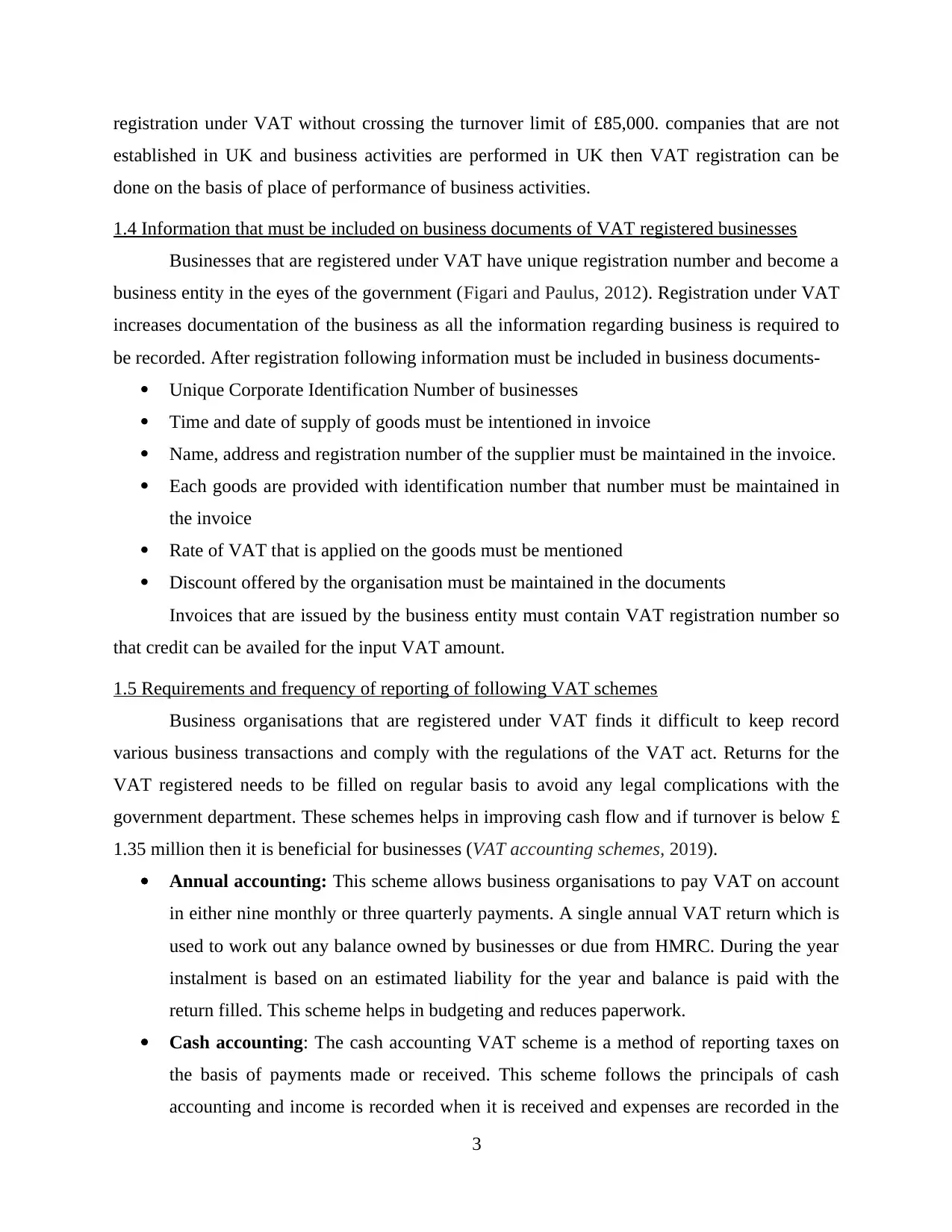
registration under VAT without crossing the turnover limit of £85,000. companies that are not
established in UK and business activities are performed in UK then VAT registration can be
done on the basis of place of performance of business activities.
1.4 Information that must be included on business documents of VAT registered businesses
Businesses that are registered under VAT have unique registration number and become a
business entity in the eyes of the government (Figari and Paulus, 2012). Registration under VAT
increases documentation of the business as all the information regarding business is required to
be recorded. After registration following information must be included in business documents-
Unique Corporate Identification Number of businesses
Time and date of supply of goods must be intentioned in invoice
Name, address and registration number of the supplier must be maintained in the invoice.
Each goods are provided with identification number that number must be maintained in
the invoice
Rate of VAT that is applied on the goods must be mentioned
Discount offered by the organisation must be maintained in the documents
Invoices that are issued by the business entity must contain VAT registration number so
that credit can be availed for the input VAT amount.
1.5 Requirements and frequency of reporting of following VAT schemes
Business organisations that are registered under VAT finds it difficult to keep record
various business transactions and comply with the regulations of the VAT act. Returns for the
VAT registered needs to be filled on regular basis to avoid any legal complications with the
government department. These schemes helps in improving cash flow and if turnover is below £
1.35 million then it is beneficial for businesses (VAT accounting schemes, 2019).
Annual accounting: This scheme allows business organisations to pay VAT on account
in either nine monthly or three quarterly payments. A single annual VAT return which is
used to work out any balance owned by businesses or due from HMRC. During the year
instalment is based on an estimated liability for the year and balance is paid with the
return filled. This scheme helps in budgeting and reduces paperwork.
Cash accounting: The cash accounting VAT scheme is a method of reporting taxes on
the basis of payments made or received. This scheme follows the principals of cash
accounting and income is recorded when it is received and expenses are recorded in the
3
established in UK and business activities are performed in UK then VAT registration can be
done on the basis of place of performance of business activities.
1.4 Information that must be included on business documents of VAT registered businesses
Businesses that are registered under VAT have unique registration number and become a
business entity in the eyes of the government (Figari and Paulus, 2012). Registration under VAT
increases documentation of the business as all the information regarding business is required to
be recorded. After registration following information must be included in business documents-
Unique Corporate Identification Number of businesses
Time and date of supply of goods must be intentioned in invoice
Name, address and registration number of the supplier must be maintained in the invoice.
Each goods are provided with identification number that number must be maintained in
the invoice
Rate of VAT that is applied on the goods must be mentioned
Discount offered by the organisation must be maintained in the documents
Invoices that are issued by the business entity must contain VAT registration number so
that credit can be availed for the input VAT amount.
1.5 Requirements and frequency of reporting of following VAT schemes
Business organisations that are registered under VAT finds it difficult to keep record
various business transactions and comply with the regulations of the VAT act. Returns for the
VAT registered needs to be filled on regular basis to avoid any legal complications with the
government department. These schemes helps in improving cash flow and if turnover is below £
1.35 million then it is beneficial for businesses (VAT accounting schemes, 2019).
Annual accounting: This scheme allows business organisations to pay VAT on account
in either nine monthly or three quarterly payments. A single annual VAT return which is
used to work out any balance owned by businesses or due from HMRC. During the year
instalment is based on an estimated liability for the year and balance is paid with the
return filled. This scheme helps in budgeting and reduces paperwork.
Cash accounting: The cash accounting VAT scheme is a method of reporting taxes on
the basis of payments made or received. This scheme follows the principals of cash
accounting and income is recorded when it is received and expenses are recorded in the
3
⊘ This is a preview!⊘
Do you want full access?
Subscribe today to unlock all pages.

Trusted by 1+ million students worldwide
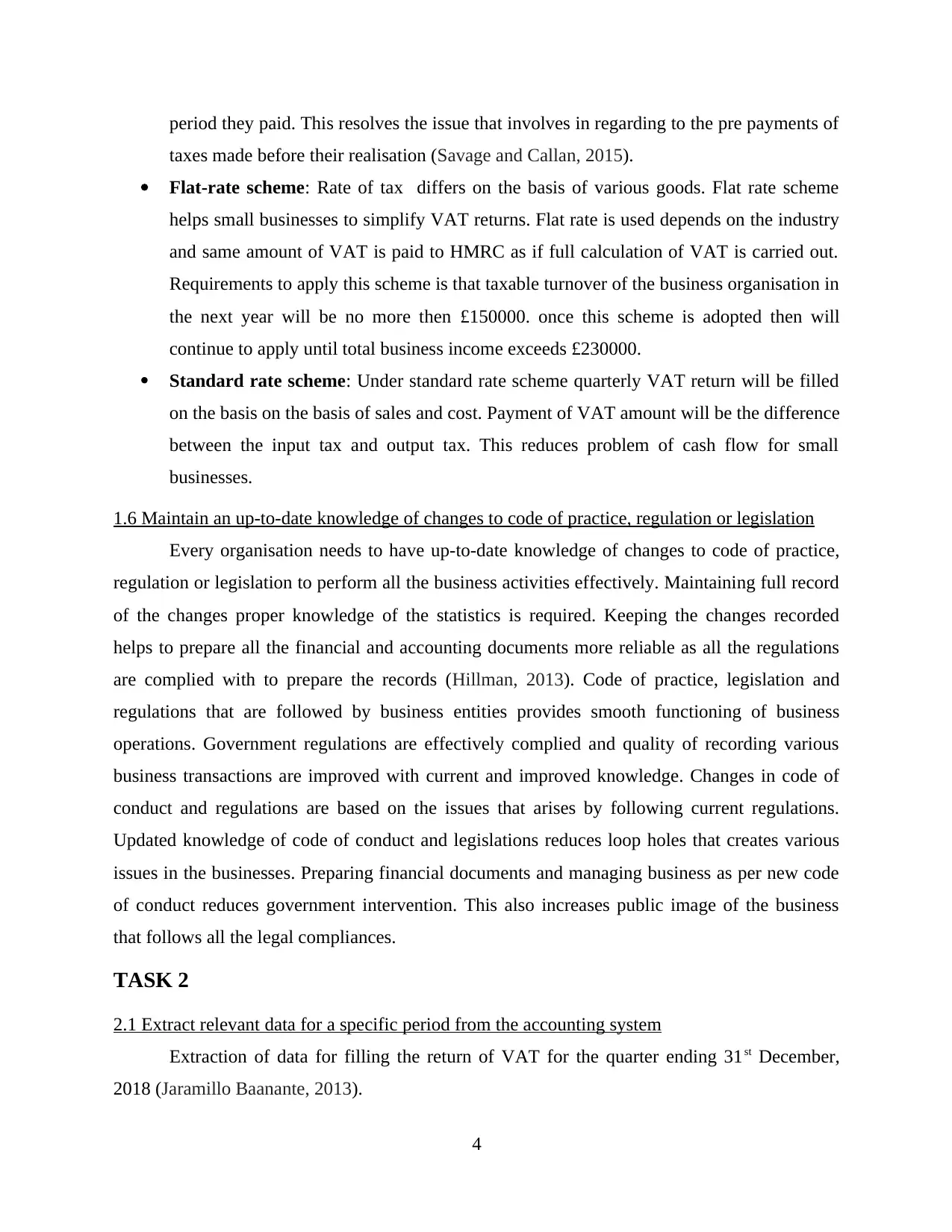
period they paid. This resolves the issue that involves in regarding to the pre payments of
taxes made before their realisation (Savage and Callan, 2015).
Flat-rate scheme: Rate of tax differs on the basis of various goods. Flat rate scheme
helps small businesses to simplify VAT returns. Flat rate is used depends on the industry
and same amount of VAT is paid to HMRC as if full calculation of VAT is carried out.
Requirements to apply this scheme is that taxable turnover of the business organisation in
the next year will be no more then £150000. once this scheme is adopted then will
continue to apply until total business income exceeds £230000.
Standard rate scheme: Under standard rate scheme quarterly VAT return will be filled
on the basis on the basis of sales and cost. Payment of VAT amount will be the difference
between the input tax and output tax. This reduces problem of cash flow for small
businesses.
1.6 Maintain an up-to-date knowledge of changes to code of practice, regulation or legislation
Every organisation needs to have up-to-date knowledge of changes to code of practice,
regulation or legislation to perform all the business activities effectively. Maintaining full record
of the changes proper knowledge of the statistics is required. Keeping the changes recorded
helps to prepare all the financial and accounting documents more reliable as all the regulations
are complied with to prepare the records (Hillman, 2013). Code of practice, legislation and
regulations that are followed by business entities provides smooth functioning of business
operations. Government regulations are effectively complied and quality of recording various
business transactions are improved with current and improved knowledge. Changes in code of
conduct and regulations are based on the issues that arises by following current regulations.
Updated knowledge of code of conduct and legislations reduces loop holes that creates various
issues in the businesses. Preparing financial documents and managing business as per new code
of conduct reduces government intervention. This also increases public image of the business
that follows all the legal compliances.
TASK 2
2.1 Extract relevant data for a specific period from the accounting system
Extraction of data for filling the return of VAT for the quarter ending 31st December,
2018 (Jaramillo Baanante, 2013).
4
taxes made before their realisation (Savage and Callan, 2015).
Flat-rate scheme: Rate of tax differs on the basis of various goods. Flat rate scheme
helps small businesses to simplify VAT returns. Flat rate is used depends on the industry
and same amount of VAT is paid to HMRC as if full calculation of VAT is carried out.
Requirements to apply this scheme is that taxable turnover of the business organisation in
the next year will be no more then £150000. once this scheme is adopted then will
continue to apply until total business income exceeds £230000.
Standard rate scheme: Under standard rate scheme quarterly VAT return will be filled
on the basis on the basis of sales and cost. Payment of VAT amount will be the difference
between the input tax and output tax. This reduces problem of cash flow for small
businesses.
1.6 Maintain an up-to-date knowledge of changes to code of practice, regulation or legislation
Every organisation needs to have up-to-date knowledge of changes to code of practice,
regulation or legislation to perform all the business activities effectively. Maintaining full record
of the changes proper knowledge of the statistics is required. Keeping the changes recorded
helps to prepare all the financial and accounting documents more reliable as all the regulations
are complied with to prepare the records (Hillman, 2013). Code of practice, legislation and
regulations that are followed by business entities provides smooth functioning of business
operations. Government regulations are effectively complied and quality of recording various
business transactions are improved with current and improved knowledge. Changes in code of
conduct and regulations are based on the issues that arises by following current regulations.
Updated knowledge of code of conduct and legislations reduces loop holes that creates various
issues in the businesses. Preparing financial documents and managing business as per new code
of conduct reduces government intervention. This also increases public image of the business
that follows all the legal compliances.
TASK 2
2.1 Extract relevant data for a specific period from the accounting system
Extraction of data for filling the return of VAT for the quarter ending 31st December,
2018 (Jaramillo Baanante, 2013).
4
Paraphrase This Document
Need a fresh take? Get an instant paraphrase of this document with our AI Paraphraser
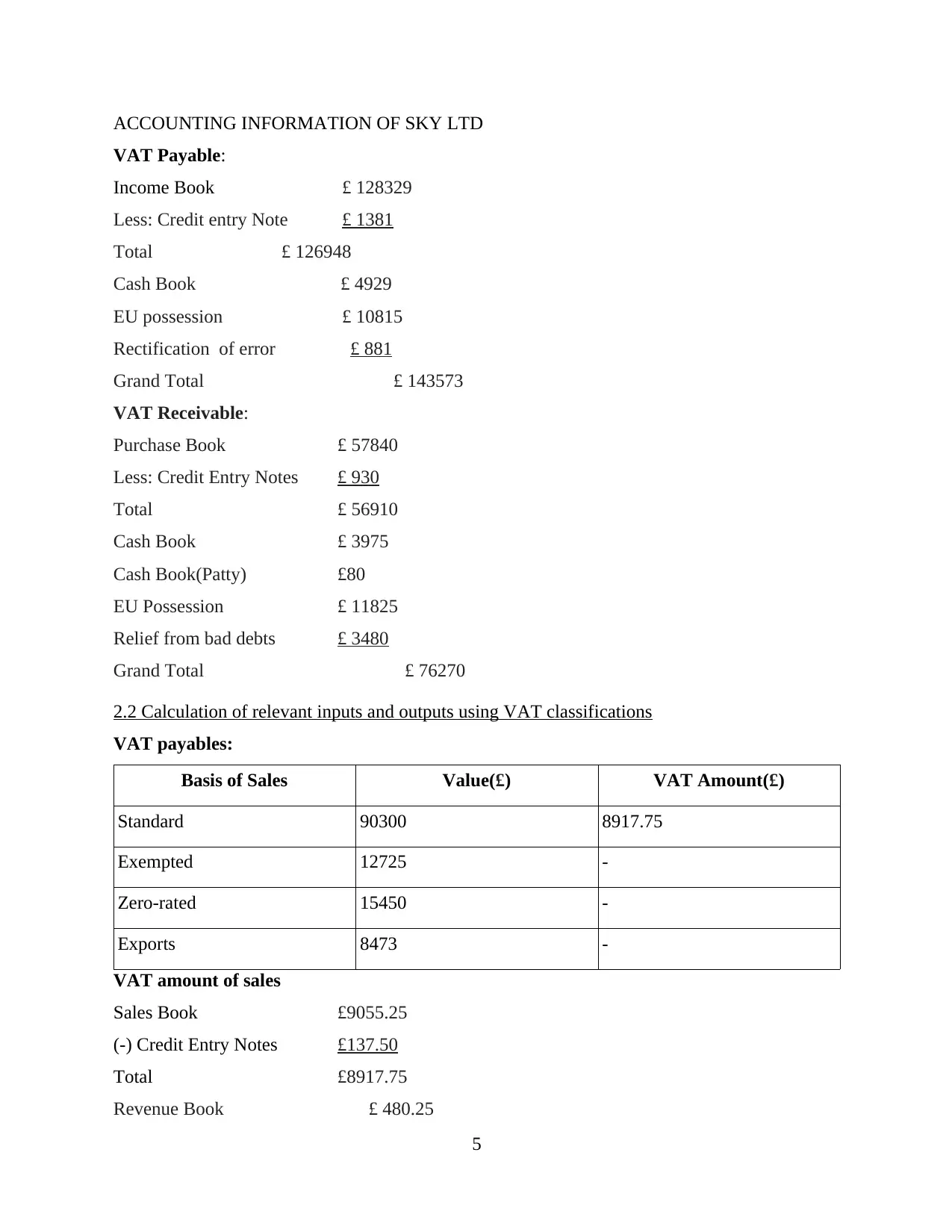
ACCOUNTING INFORMATION OF SKY LTD
VAT Payable:
Income Book £ 128329
Less: Credit entry Note £ 1381
Total £ 126948
Cash Book £ 4929
EU possession £ 10815
Rectification of error £ 881
Grand Total £ 143573
VAT Receivable:
Purchase Book £ 57840
Less: Credit Entry Notes £ 930
Total £ 56910
Cash Book £ 3975
Cash Book(Patty) £80
EU Possession £ 11825
Relief from bad debts £ 3480
Grand Total £ 76270
2.2 Calculation of relevant inputs and outputs using VAT classifications
VAT payables:
Basis of Sales Value(£) VAT Amount(£)
Standard 90300 8917.75
Exempted 12725 -
Zero-rated 15450 -
Exports 8473 -
VAT amount of sales
Sales Book £9055.25
(-) Credit Entry Notes £137.50
Total £8917.75
Revenue Book £ 480.25
5
VAT Payable:
Income Book £ 128329
Less: Credit entry Note £ 1381
Total £ 126948
Cash Book £ 4929
EU possession £ 10815
Rectification of error £ 881
Grand Total £ 143573
VAT Receivable:
Purchase Book £ 57840
Less: Credit Entry Notes £ 930
Total £ 56910
Cash Book £ 3975
Cash Book(Patty) £80
EU Possession £ 11825
Relief from bad debts £ 3480
Grand Total £ 76270
2.2 Calculation of relevant inputs and outputs using VAT classifications
VAT payables:
Basis of Sales Value(£) VAT Amount(£)
Standard 90300 8917.75
Exempted 12725 -
Zero-rated 15450 -
Exports 8473 -
VAT amount of sales
Sales Book £9055.25
(-) Credit Entry Notes £137.50
Total £8917.75
Revenue Book £ 480.25
5
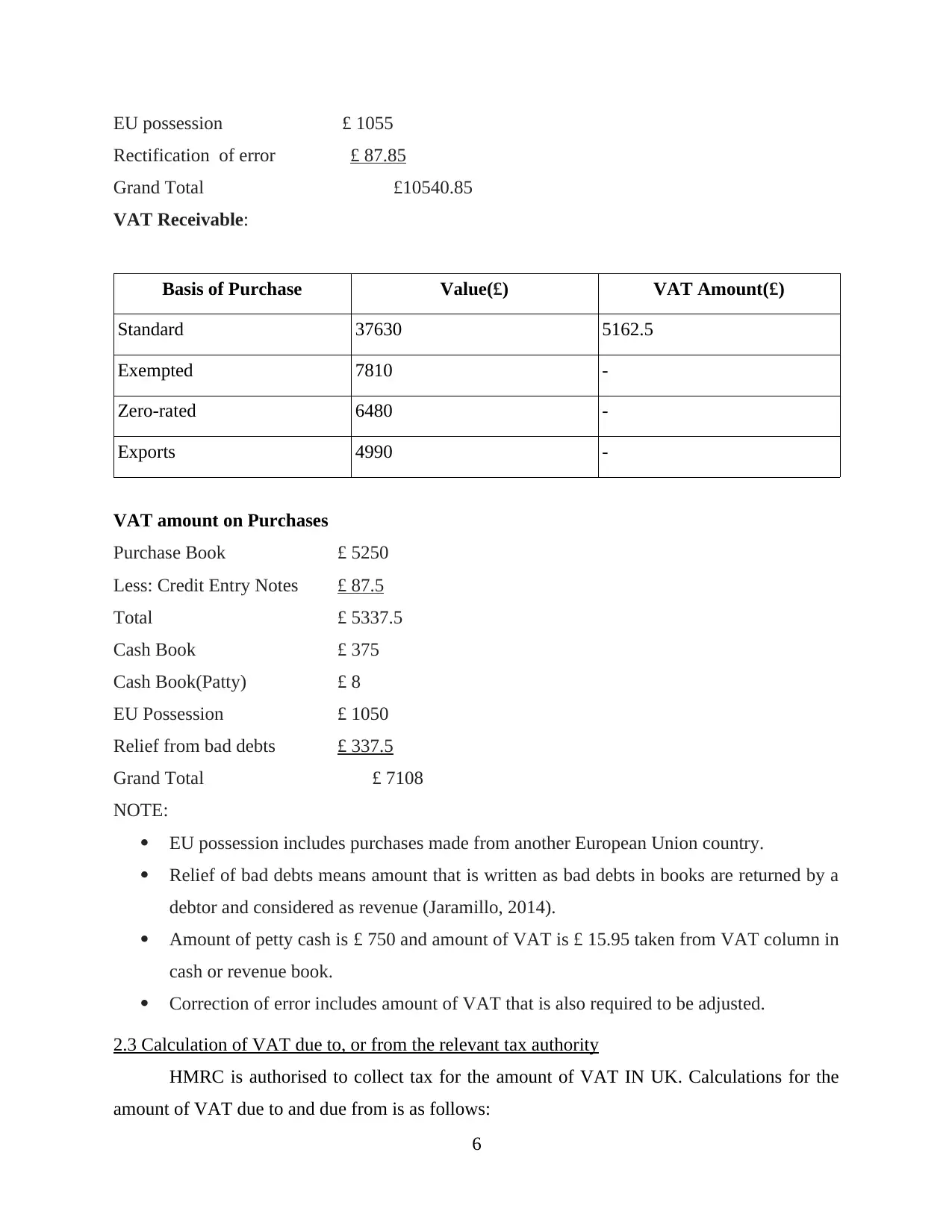
EU possession £ 1055
Rectification of error £ 87.85
Grand Total £10540.85
VAT Receivable:
Basis of Purchase Value(£) VAT Amount(£)
Standard 37630 5162.5
Exempted 7810 -
Zero-rated 6480 -
Exports 4990 -
VAT amount on Purchases
Purchase Book £ 5250
Less: Credit Entry Notes £ 87.5
Total £ 5337.5
Cash Book £ 375
Cash Book(Patty) £ 8
EU Possession £ 1050
Relief from bad debts £ 337.5
Grand Total £ 7108
NOTE:
EU possession includes purchases made from another European Union country.
Relief of bad debts means amount that is written as bad debts in books are returned by a
debtor and considered as revenue (Jaramillo, 2014).
Amount of petty cash is £ 750 and amount of VAT is £ 15.95 taken from VAT column in
cash or revenue book.
Correction of error includes amount of VAT that is also required to be adjusted.
2.3 Calculation of VAT due to, or from the relevant tax authority
HMRC is authorised to collect tax for the amount of VAT IN UK. Calculations for the
amount of VAT due to and due from is as follows:
6
Rectification of error £ 87.85
Grand Total £10540.85
VAT Receivable:
Basis of Purchase Value(£) VAT Amount(£)
Standard 37630 5162.5
Exempted 7810 -
Zero-rated 6480 -
Exports 4990 -
VAT amount on Purchases
Purchase Book £ 5250
Less: Credit Entry Notes £ 87.5
Total £ 5337.5
Cash Book £ 375
Cash Book(Patty) £ 8
EU Possession £ 1050
Relief from bad debts £ 337.5
Grand Total £ 7108
NOTE:
EU possession includes purchases made from another European Union country.
Relief of bad debts means amount that is written as bad debts in books are returned by a
debtor and considered as revenue (Jaramillo, 2014).
Amount of petty cash is £ 750 and amount of VAT is £ 15.95 taken from VAT column in
cash or revenue book.
Correction of error includes amount of VAT that is also required to be adjusted.
2.3 Calculation of VAT due to, or from the relevant tax authority
HMRC is authorised to collect tax for the amount of VAT IN UK. Calculations for the
amount of VAT due to and due from is as follows:
6
⊘ This is a preview!⊘
Do you want full access?
Subscribe today to unlock all pages.

Trusted by 1+ million students worldwide
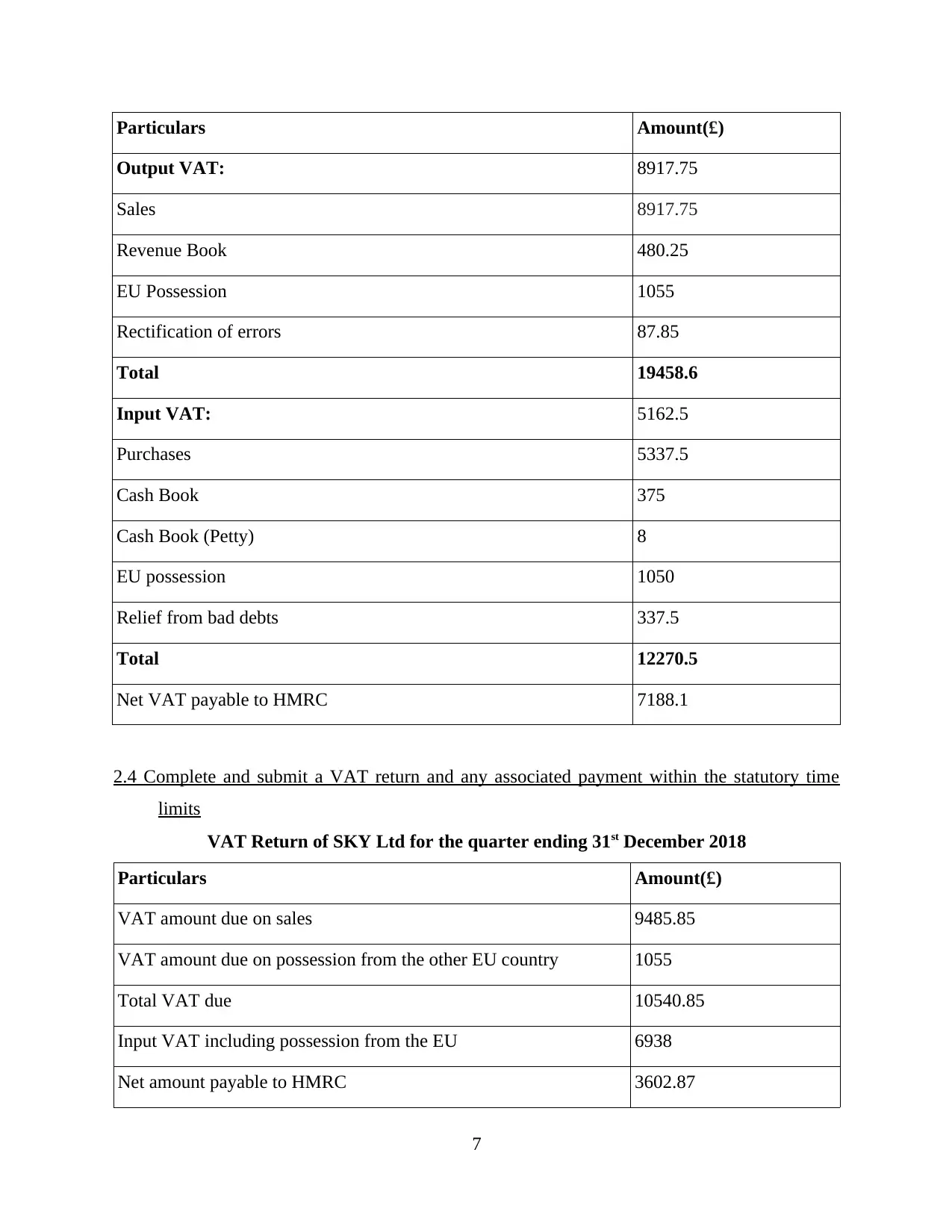
Particulars Amount(£)
Output VAT: 8917.75
Sales 8917.75
Revenue Book 480.25
EU Possession 1055
Rectification of errors 87.85
Total 19458.6
Input VAT: 5162.5
Purchases 5337.5
Cash Book 375
Cash Book (Petty) 8
EU possession 1050
Relief from bad debts 337.5
Total 12270.5
Net VAT payable to HMRC 7188.1
2.4 Complete and submit a VAT return and any associated payment within the statutory time
limits
VAT Return of SKY Ltd for the quarter ending 31st December 2018
Particulars Amount(£)
VAT amount due on sales 9485.85
VAT amount due on possession from the other EU country 1055
Total VAT due 10540.85
Input VAT including possession from the EU 6938
Net amount payable to HMRC 3602.87
7
Output VAT: 8917.75
Sales 8917.75
Revenue Book 480.25
EU Possession 1055
Rectification of errors 87.85
Total 19458.6
Input VAT: 5162.5
Purchases 5337.5
Cash Book 375
Cash Book (Petty) 8
EU possession 1050
Relief from bad debts 337.5
Total 12270.5
Net VAT payable to HMRC 7188.1
2.4 Complete and submit a VAT return and any associated payment within the statutory time
limits
VAT Return of SKY Ltd for the quarter ending 31st December 2018
Particulars Amount(£)
VAT amount due on sales 9485.85
VAT amount due on possession from the other EU country 1055
Total VAT due 10540.85
Input VAT including possession from the EU 6938
Net amount payable to HMRC 3602.87
7
Paraphrase This Document
Need a fresh take? Get an instant paraphrase of this document with our AI Paraphraser
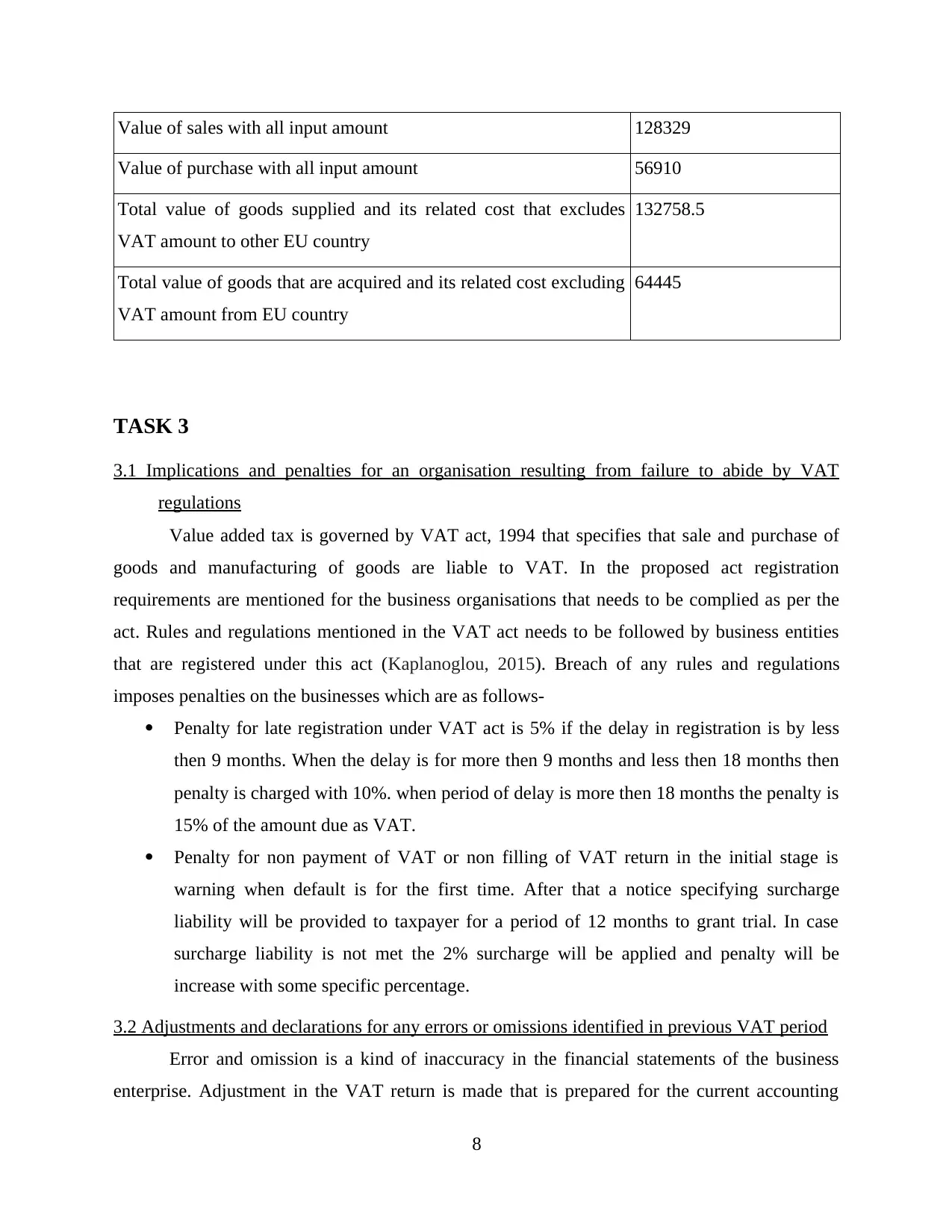
Value of sales with all input amount 128329
Value of purchase with all input amount 56910
Total value of goods supplied and its related cost that excludes
VAT amount to other EU country
132758.5
Total value of goods that are acquired and its related cost excluding
VAT amount from EU country
64445
TASK 3
3.1 Implications and penalties for an organisation resulting from failure to abide by VAT
regulations
Value added tax is governed by VAT act, 1994 that specifies that sale and purchase of
goods and manufacturing of goods are liable to VAT. In the proposed act registration
requirements are mentioned for the business organisations that needs to be complied as per the
act. Rules and regulations mentioned in the VAT act needs to be followed by business entities
that are registered under this act (Kaplanoglou, 2015). Breach of any rules and regulations
imposes penalties on the businesses which are as follows-
Penalty for late registration under VAT act is 5% if the delay in registration is by less
then 9 months. When the delay is for more then 9 months and less then 18 months then
penalty is charged with 10%. when period of delay is more then 18 months the penalty is
15% of the amount due as VAT.
Penalty for non payment of VAT or non filling of VAT return in the initial stage is
warning when default is for the first time. After that a notice specifying surcharge
liability will be provided to taxpayer for a period of 12 months to grant trial. In case
surcharge liability is not met the 2% surcharge will be applied and penalty will be
increase with some specific percentage.
3.2 Adjustments and declarations for any errors or omissions identified in previous VAT period
Error and omission is a kind of inaccuracy in the financial statements of the business
enterprise. Adjustment in the VAT return is made that is prepared for the current accounting
8
Value of purchase with all input amount 56910
Total value of goods supplied and its related cost that excludes
VAT amount to other EU country
132758.5
Total value of goods that are acquired and its related cost excluding
VAT amount from EU country
64445
TASK 3
3.1 Implications and penalties for an organisation resulting from failure to abide by VAT
regulations
Value added tax is governed by VAT act, 1994 that specifies that sale and purchase of
goods and manufacturing of goods are liable to VAT. In the proposed act registration
requirements are mentioned for the business organisations that needs to be complied as per the
act. Rules and regulations mentioned in the VAT act needs to be followed by business entities
that are registered under this act (Kaplanoglou, 2015). Breach of any rules and regulations
imposes penalties on the businesses which are as follows-
Penalty for late registration under VAT act is 5% if the delay in registration is by less
then 9 months. When the delay is for more then 9 months and less then 18 months then
penalty is charged with 10%. when period of delay is more then 18 months the penalty is
15% of the amount due as VAT.
Penalty for non payment of VAT or non filling of VAT return in the initial stage is
warning when default is for the first time. After that a notice specifying surcharge
liability will be provided to taxpayer for a period of 12 months to grant trial. In case
surcharge liability is not met the 2% surcharge will be applied and penalty will be
increase with some specific percentage.
3.2 Adjustments and declarations for any errors or omissions identified in previous VAT period
Error and omission is a kind of inaccuracy in the financial statements of the business
enterprise. Adjustment in the VAT return is made that is prepared for the current accounting
8
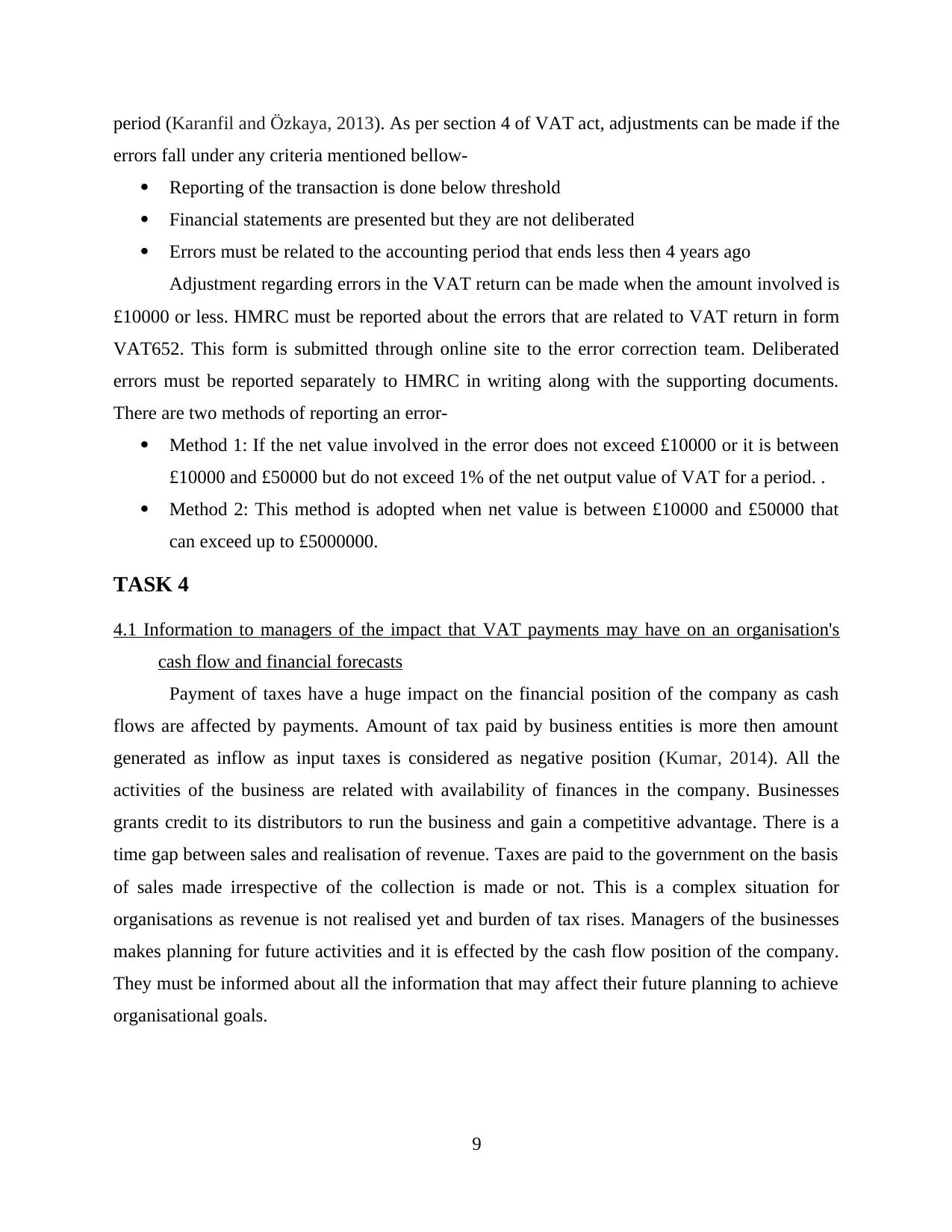
period (Karanfil and Özkaya, 2013). As per section 4 of VAT act, adjustments can be made if the
errors fall under any criteria mentioned bellow-
Reporting of the transaction is done below threshold
Financial statements are presented but they are not deliberated
Errors must be related to the accounting period that ends less then 4 years ago
Adjustment regarding errors in the VAT return can be made when the amount involved is
£10000 or less. HMRC must be reported about the errors that are related to VAT return in form
VAT652. This form is submitted through online site to the error correction team. Deliberated
errors must be reported separately to HMRC in writing along with the supporting documents.
There are two methods of reporting an error-
Method 1: If the net value involved in the error does not exceed £10000 or it is between
£10000 and £50000 but do not exceed 1% of the net output value of VAT for a period. .
Method 2: This method is adopted when net value is between £10000 and £50000 that
can exceed up to £5000000.
TASK 4
4.1 Information to managers of the impact that VAT payments may have on an organisation's
cash flow and financial forecasts
Payment of taxes have a huge impact on the financial position of the company as cash
flows are affected by payments. Amount of tax paid by business entities is more then amount
generated as inflow as input taxes is considered as negative position (Kumar, 2014). All the
activities of the business are related with availability of finances in the company. Businesses
grants credit to its distributors to run the business and gain a competitive advantage. There is a
time gap between sales and realisation of revenue. Taxes are paid to the government on the basis
of sales made irrespective of the collection is made or not. This is a complex situation for
organisations as revenue is not realised yet and burden of tax rises. Managers of the businesses
makes planning for future activities and it is effected by the cash flow position of the company.
They must be informed about all the information that may affect their future planning to achieve
organisational goals.
9
errors fall under any criteria mentioned bellow-
Reporting of the transaction is done below threshold
Financial statements are presented but they are not deliberated
Errors must be related to the accounting period that ends less then 4 years ago
Adjustment regarding errors in the VAT return can be made when the amount involved is
£10000 or less. HMRC must be reported about the errors that are related to VAT return in form
VAT652. This form is submitted through online site to the error correction team. Deliberated
errors must be reported separately to HMRC in writing along with the supporting documents.
There are two methods of reporting an error-
Method 1: If the net value involved in the error does not exceed £10000 or it is between
£10000 and £50000 but do not exceed 1% of the net output value of VAT for a period. .
Method 2: This method is adopted when net value is between £10000 and £50000 that
can exceed up to £5000000.
TASK 4
4.1 Information to managers of the impact that VAT payments may have on an organisation's
cash flow and financial forecasts
Payment of taxes have a huge impact on the financial position of the company as cash
flows are affected by payments. Amount of tax paid by business entities is more then amount
generated as inflow as input taxes is considered as negative position (Kumar, 2014). All the
activities of the business are related with availability of finances in the company. Businesses
grants credit to its distributors to run the business and gain a competitive advantage. There is a
time gap between sales and realisation of revenue. Taxes are paid to the government on the basis
of sales made irrespective of the collection is made or not. This is a complex situation for
organisations as revenue is not realised yet and burden of tax rises. Managers of the businesses
makes planning for future activities and it is effected by the cash flow position of the company.
They must be informed about all the information that may affect their future planning to achieve
organisational goals.
9
⊘ This is a preview!⊘
Do you want full access?
Subscribe today to unlock all pages.

Trusted by 1+ million students worldwide
1 out of 14
Related Documents
Your All-in-One AI-Powered Toolkit for Academic Success.
+13062052269
info@desklib.com
Available 24*7 on WhatsApp / Email
![[object Object]](/_next/static/media/star-bottom.7253800d.svg)
Unlock your academic potential
Copyright © 2020–2025 A2Z Services. All Rights Reserved. Developed and managed by ZUCOL.





